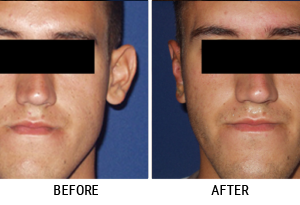Cosmetic facial surgery | Ear Reshaping (Otoplasty)
Ear Corrective Surgery- Otoplasty
Otoplasty –is also known as aesthetic corrective surgery of the ears . It is a procedure for that’s changes the shape, position or size of the ears.

As a rule, patients opt for Otoplastics for aesthetic reasons, primarily if they are bothered by the prominence of their ears. However, this procedure can also be considered if the ear or ears are injured or due to congenital anomaly.
Otoplasty is one of the most common aesthetic corrective surgeries.
Otoplasty can be done at any age, although it is recommended that it be done only after the ears reach their full size.
Why is the surgical correction of the ears performed?
– If the ear or ears are too far from the head (more than 2 cm from the head is considered critical)
– If the ears are large in proportion to the head
– Lop-eared
– Sharper ears
– Strange shaped ears
– Asymmetrical ears
– Injuries to the ears
– If you are not satisfied with the previous surgery of your ears
Otoplasty is usually performed on both ears, due to the optimization of symmetry. Otoplasty will not change your ability to hear or the general sense of your ears.
If you have opted to do an Otoplasty, you will need to prepares yourself for the procedure which consists of three essential stages: preparation for surgery, surgery and postoperative phase (recovery from surgery).
Preparing for surgery
The surgeon will ask you about your history of illness. Be prepared to answer questions about your current and past medical conditions, especially concerning ear infections. Talk about any medicines you are taking or have recently taken (including supplements), as well as all the operations that you have had performed.
The surgeon will also perform an ear exam – this include their position, size, shape and symmetry. The surgeon will also make a few photos of the ears, which can be used as reference during the procedure itself.
All information about preoperative preparation will be provided by your doctor. It will probably be necessary to avoid the use of aspirin, anti-inflammatory drugs and certain herbal supplements at least 2 weeks prior to surgery, as they may increase bleeding.
Smoking reduces the blood flow to the skin and can slow down the healing process. If you smoke, your doctor will recommend that you stop smoking before surgery and during recovery.
How is the Otoplasty performed?
Ear surgery is most often performed in local anesthesia. Otoplastic techniques vary based on what type of correction is needed. The specific technique chosen by your surgeon will determine the location of the cuts and scars.
Aesthetic surgeon can make cuts:
- on the back part of the ears
- inside the inner part of the ears
After making cuts, if necessary, a surgeon can remove excess cartilage and / or skin from the ears. Then the cartilage overlaps in the appropriate position and fastens with the inner seams. Additional seams will be used to close cuts. The careful shaping of the cartilage as well as the contraction of the basic ear elements result in the desired shape and natural symmetry. The scars remain completely hidden in the contours behind the ear and will often be completely non-visible after a recovery period.
The ear correction (Otoplasty) procedure usually takes about two hours.
Post Otoplasty

After the procedure, your ears will be covered with protective bandages, which are there for protection and support. These bandages can be replaced by light bandages after a few days.
In the first period, moderate swelling, bruising, itching and mild discomfort can be expected. If needed, your doctor will have prescribed you painkillers.
Please avoid sleeping on your side in order to prevent pressure buildup. Also try not to exert pressure or excessive force on the cuts. It is recommended that you avoid wearing clothes that are being put on over your head.
A few days after an ear correction, your doctor will remove the bandages. Your ears will probably be swollen and red. You will have to wear loose head coverings, which will cover the ears, overnight for two to six weeks. This will prevent you from injuring or aggravating your ears while sleeping.
Consult your doctor when it’s okay to continue your day-to-day activities, such as swimming and other physical activities.
You will receive detailed postoperative instructions from your doctor that should be followed in order to achieve optimum results, accelerate recovery and avoid complications.
Returning to school or work can commence approximately one-week post- surgery, while younger children should avoid returning to school, and social activities for a longer period in order not to delay the healing process. More demanding activities and sports training should be avoided about four weeks after surgery, although your doctor will determine the exact recovery time for the particular case.
Results
After removing the bandages, you will notice an immediate change in the shape of your ears, and these changes are permanent.
Possible risks of the ears correction procedure
Surgical ear correction carries with it various risks, including:
– Scars (although permanent, usually hidden behind your ears or inside the ears)
– asymmetry of the ear positions
– Changes in skin sensation (this is generally not permanent)
– Problems involving stitches
– Unnatural contours, and placing the ears too far back
Like all other types of surgery, Otoplasty carries the risk of bleeding, infection, and an adverse reaction to anesthesia. It is also possible to have an allergic reaction to the surgical tape or other materials used during or after the procedure.
For more information, please contact our call center: +381 11 785 88 88
